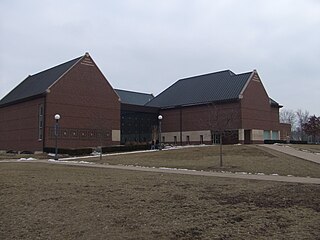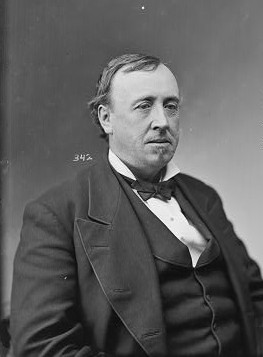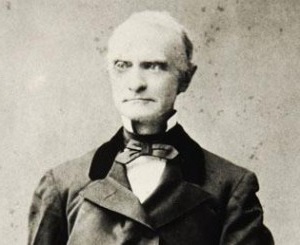
Bloomington is a city in and the county seat of McLean County, Illinois, United States. The 2020 census showed the city had a population of 78,680, making it the 13th-most populous city in Illinois and the fifth-most populous outside the Chicago metropolitan area. It is adjacent to the town of Normal, and is the more populous of the two principal municipalities of the Bloomington–Normal metropolitan area, which has a population of roughly 170,000. Bloomington is 135 miles (217 km) southwest of Chicago and 162 miles (261 km) northeast of St. Louis. Bloomington is home to Illinois Wesleyan University and the headquarters for State Farm and Country Financial. Bloomington is also home to the minor league hockey team Bloomington Bison.
The Peel Art Gallery, Museum and Archives (PAMA) is a museum, art gallery, and archives for the Regional Municipality of Peel and are located in Brampton, Ontario, Canada. Previously, it was the Peel Heritage Complex. Its facilities were originally the Peel County Courthouse, Brampton Jail, a land registry office, and a county administration building. It is opposite Gage Park and Brampton City Hall.

The Museum of the City of New York (MCNY) is a history and art museum in Manhattan, New York City, New York. It was founded by Henry Collins Brown, in 1923 to preserve and present the history of New York City, and its people. It is located at 1220–1227 Fifth Avenue between East 103rd to 104th Streets, across from Central Park on Manhattan's Upper East Side, at the northern end of the Museum Mile section of Fifth Avenue.

Chicago History Museum is the museum of the Chicago Historical Society (CHS). The CHS was founded in 1856 to study and interpret Chicago's history. The museum has been located in Lincoln Park since the 1930s at 1601 North Clark Street at the intersection of North Avenue in the Old Town Triangle neighborhood, where the museum has been expanded several times. Long known as the CHS, the society adopted the name, Chicago History Museum, in September 2006 for its public presence.

Jesse W. Fell was an American businessman and landowner. He was instrumental in the founding of Illinois State University as well as Normal, Pontiac, Clinton, Towanda, Dwight, DeWitt County and Livingston County in Central Illinois. He was also the founder of the newspaper The Pantagraph. As a close friend of Abraham Lincoln, it was Fell who urged him to challenge his opponent, Stephen A. Douglas, to their famous series of debates.
Evergreen Cemetery is a cemetery in Bloomington, Illinois. It is also known as Evergreen Memorial Cemetery.

Miller Park is a public park in Bloomington, Illinois, United States. It is in the southwest part of the city, on a large block south of Wood Street and east of Morris Avenue.

The William R. and Clarice V. Spurlock Museum, better known as the Spurlock Museum, is an ethnographic museum at the University of Illinois at Urbana-Champaign. The Spurlock Museum's permanent collection includes portions of collections from other museums and units on the Urbana-Champaign campus such as cultural artifacts from the Museum of Natural History and Department of Anthropology as well as historic clothing from the Bevier Collection of the College of Agricultural, Consumer and Environmental Sciences. The museum also holds objects donated by other institutions and private individuals. With approximately 51,000 objects in its artifact collection, the Spurlock Museum at the University of Illinois at Urbana-Champaign collects, preserves, documents, exhibits, and studies objects of cultural heritage. The museum's main galleries, highlighting the ancient Mediterranean, modern Africa, ancient Egypt, Mesopotamia, East Asia, Oceania, Europe, and the Americas, celebrate the diversity of cultures through time and across the globe.

The Indiana State Museum is a museum located in downtown Indianapolis, Indiana, United States. The museum houses exhibits on the science, art, culture, and history of Indiana from prehistoric times to the present day.

The McLean County Courthouse and Square is located in downtown Bloomington, Illinois. The site is on the National Register of Historic Places and encompasses the old McLean County Courthouse and the courthouse-facing sides of three downtown blocks. All 4 floors of the building are now occupied by the McLean County Museum of History for exhibits, collections storage, and offices. The historic buildings at the other side of the square were destroyed by fire in the 1980s. The Square is bordered by four Bloomington streets: Main Street, Center Street, Jefferson Street and Washington Street. The site was home to three previous courthouses before the current one was completed in 1903. The first courthouse at the site was built in 1831, and the second in 1836. The third was built in 1868, but suffered major damage from fire on June 19, 1900.

Thomas Foster Tipton was a U.S. Representative from Illinois.

John Milton Scott was an American attorney, judge, politician and philanthropist from Illinois. Although he did not win election to the Illinois Senate from Bloomington, Illinois, he served on both the Illinois Circuit Courts (1862-1870) and the Supreme Court of Illinois (1870-1888), including three one-year terms as chief justice. The trust he established in his will funded the first hospital in Bloomington and continues to fund local healthcare today.

The Buffalo History Museum is located at 1 Museum Court in Buffalo, New York, just east of Elmwood Avenue and off of Nottingham Terrace, north of the Scajaquada Expressway, in the northwest corner of Delaware Park.

Save America's Treasures is a United States federal government initiative to preserve and protect historic buildings, arts, and published works. It is a public–private partnership between the U.S. National Park Service and the National Trust for Historic Preservation. The National Endowment for the Arts, National Endowment for the Humanities, and Institute of Museum and Library Services are also partners in the work. In the early years of the program, Heritage Preservation and the National Park Foundation were also involved.

David Davis was an American politician and jurist who was a U.S. senator from Illinois and associate justice of the United States Supreme Court. He also served as Abraham Lincoln's campaign manager at the 1860 Republican National Convention, engineering Lincoln's successful nomination for president by that party.

The Chemung County Historical Society is headquartered in the historic Chemung Canal Bank Building in Elmira, New York. It is dedicated to the collection, preservation, and presentation of the history of the Chemung River Valley region. The society was founded in 1923 and first chartered by New York State in 1947. It is accredited by the American Alliance of Museums, and currently operates two cultural repositories, the Chemung Valley History Museum and the Booth Library, both as non-profit educational institutions.

The McClurg Museum is a renovated mansion in Westfield, New York that serves as the home of the Chautauqua County Historical Society. It is a volunteer-run museum containing various artifacts collected by the historical society along with an extensive library and photo collection. It is open to the public and local schools for educational purposes.

The Tilbury Flash is a single-seat American racing monoplane designed and built in the 1930s by Owen Tilbury and Cecil Fundy. The aircraft was built in 1932 and was entered in the US National Air Races. At Cleveland, at the time it was described as probably the smallest racing aeroplane in the world.

Asahel Gridley was an American politician, lawyer, merchant, and banker. Born in New York, Gridley moved to Bloomington, Illinois, when he was twenty-one. He served as a brigadier general in the Black Hawk War and was elected to three terms in the Illinois General Assembly. There, he lobbied to have the Illinois Central and Chicago and Alton Railroads pass near Bloomington. Abraham Lincoln once defended Gridley during a slander trial and was a frequent collaborator or opponent in the courts. Gridley is also the namesake of Gridley, Illinois, and platted two other McLean County towns.

The Historical Society of Baltimore County (HSBC) was founded in 1959 with the goal of preserving, interpreting, and illustrating the history of Baltimore County for the benefit of present and future generations of Marylanders, and is a resource for those interested in researching both local and family history. As the HSBC describes it, they "continually accomplish" their mission "through the production of presentations, lectures, workshops, entertaining educational publications, historical tours, and exhibits." Centrally located in Cockeysville, Maryland, the Society operates out of the Agriculture Building, the former Baltimore County Almshouse, which was built in 1872 and used to house the poor and mentally ill of Baltimore County until 1958.




















